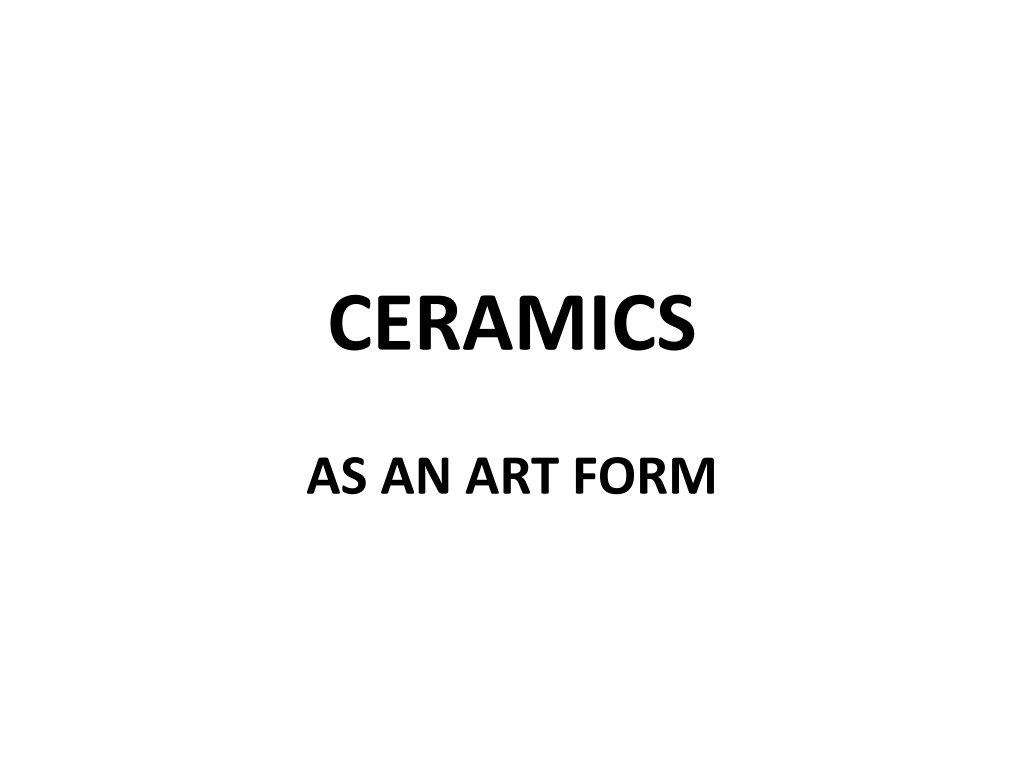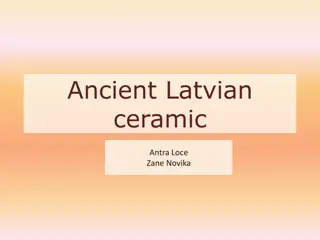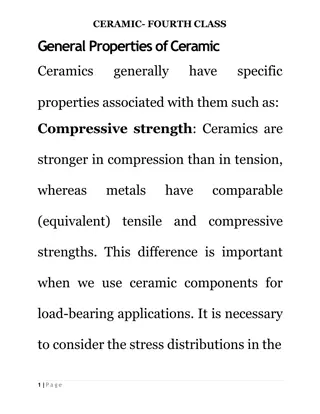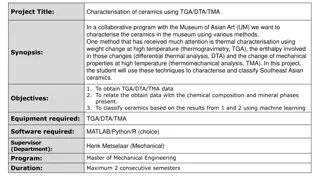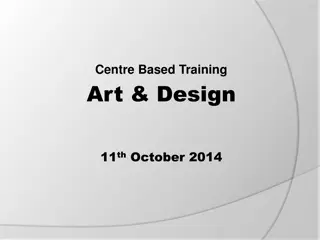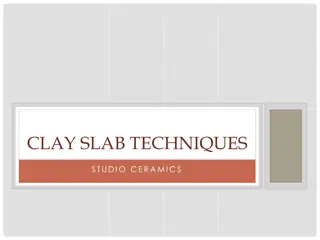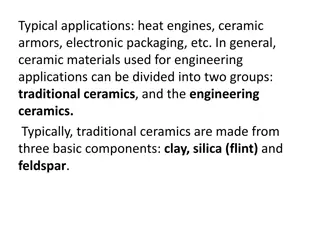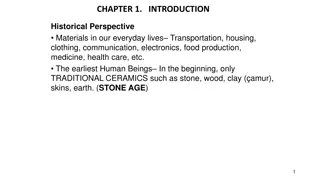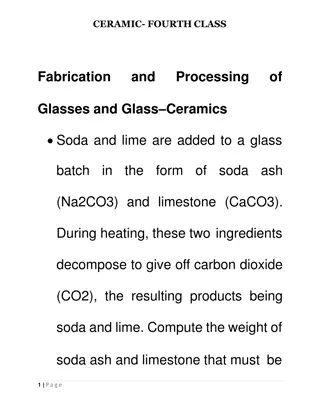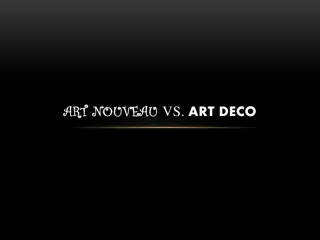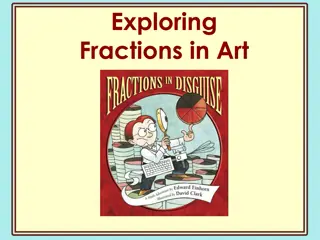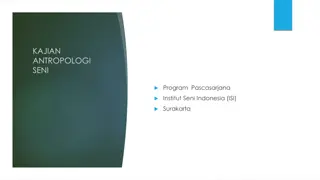Exploring Ceramics as an Art Form
Ceramics as an art form involves shaping and designing objects from clay, which are hardened through high-temperature kiln firing. Ceramic art encompasses a wide range of products, from fine art pieces to decorative or industrial objects. This art form can be practiced by individuals or in a group setting, with tools and materials ranging from household items to specialized clay types like earthenware and porcelain. The process involves preparing the clay and molding it into the desired form before firing in a kiln.
Download Presentation

Please find below an Image/Link to download the presentation.
The content on the website is provided AS IS for your information and personal use only. It may not be sold, licensed, or shared on other websites without obtaining consent from the author. Download presentation by click this link. If you encounter any issues during the download, it is possible that the publisher has removed the file from their server.
E N D
Presentation Transcript
CERAMICS AS AN ART FORM
Definition Something which is made out of clay and permanently hardened by heat (burnt in kiln on high temperature). This is the art of shaping clay and designing any object out of clay.
In art history, ceramic art mean art objects such as figures, tiles, and tableware made from clay and other raw materials by the process of pottery. Some ceramic products are regarded as fine art, while others are regarded as decorative, industrial or applied art objects, or as artifacts in archaeology.
They may be made by one individual or in a factory where a group of people design, make and decorate the ware. Decorative ceramics are sometimes called "art pottery".
MATERIALS AND EQUIPMENT A great many of the tools can be improvised from discarded household items like: o An out-of-date credit card is a most useful soothing tool, pencils, bits of old wood can all be shaped into the modelling tool that is perfect for the form you are about to make.
Equipment are listed below: CLAY: It is advisable to buy clay ready prepared in bags as it is more consistent in quality and texture. There are two types of sources of clay: One is primary clay that is locally available and belongs to origin. Other is Secondary clay also known as Sedimentary Clay. This kind of clay is gained from the flooded water. Which is imported and brought by man power from the beds of rivers. It has elasticity in it. It is mostly known as Red Clay.
Earthenware (Terracotta or Red Clay) Stoneware (White Clay) China Clay: used for crockery, tiles and it turns white when heated. Porcelain: very fine white clay Grog: Waste or Damaged left over material. Grinded crushed stone, raw form, not refined, used to absorb moisture in clay. Silica Sand: It has a binder to make the red clay more consistent A prepared clay is usually called a body.
Process Dry clay is beaten up with a wooden stick then it is filtered with the help of wire mesh called Channana. Clay Kneading: in that dry clay we add water to knead it. The purpose of kneading the clay is to remove air from it and it helps in achieving elasticity. Wedging is the process to remove air bubbles in the clay. The dry clay in powder form is called Khushka.
Tools Needed 1. Wheel is locally known as Chakk or Chakka. Hand itself is a biggest tool. Patri a tool of steel which is used to remove extra clay. Brush which is mostly made from Goat hairs is used for giving the fine finish to the pot. Molds or dai made from plaster of Paris. Metallic String used for cutting off the object or pot from the base of the wheel.
Process of making a pot on wheel. Clay pots are shaped on a potter's wheel. The potter puts a lump of wet clay on a disc (the wheel), and make the wheel spin. As the clay spins on the wheel, the potter shapes the pot by hands. After drying the finished pot goes into a kiln to 'fire or to harden it.
CONSTRUCTION TOOLS These tools are primarily used in the actual making of ceramic objects: 1. Kidneys both metal and rubber, are used for smoothing work. 2. Turning Tools for cleaning up the form on the wheel. 3. Rolling Pin enables you to roll clay to a consistent thickness.
Modelling Tools Callipers Hole Makers Clay Cutting Needle Cheese Wire Sponge Rubber Gloves Sand paper for smoothing the dried clay object
BASIC TECHNIQUES & METHODS Wheel Throwing Slabbing or Slab Method Coil Method Pinch Method Molding & Casting Method
PROCESS Making of a pot or designing a clay Keep it for drying Bisque firing (semi firing) Surface decoration is a hand painting or engraving. Relief can also be carved. It is most in the form of pottery stickers. Glazing: dip in the glaze Firing.
Surface Decoration. There are four types of surface decoration 1. Engraving 2. Perforation 3. Painting 4. pottery Stickers
Patterns of Surface Decoration Loops patterns Lozenges patterns Wavy patterns Triangular Grid Patterns Cross Etching Floral
Glazing Glaze comes in powder form, ready mixed with water or in brush-on form. You have to add water until it achieves the consistency of single cream. For the spray glaze the mixture should not be apply too thickly as this will make it crawl, craze or run down the side of your pot when fired.
For your safety when mixing or spraying glaze , you should always wear a mask. For dipping a pot, the glaze will need to be much thinner in consistency than that mixed for spraying.
Firing Most work will entail two firings: The first called a Bisque firing when the pot has become bone dry. The temperatures will vary according to the type of clay used. The secondary firing is called the glaze or gloss firing, the object begin to melt the glaze and fuse it to the body of the pot. This will result in a waterproof surface.
Firing Temperature Earthenware 750 to 850 Degree Centigrade Stoneware 1150 to 1250 Degree Centigrade Porcelain 1300 to 1500 Degree Centigrade
KILNS There are three types of Kilns: 1. Fire Wood Kiln 2. Electric Kilns 3. Sui gas Kilns
Coiling Using coils, forms are built up into the desired size and shape. Coiled pots can take on any number of forms, and can be tiny or huge. The coils may or may not be completely welded together, depending on the desired surface effect.
Early pots were made by what is known as the "coiling" method, which worked the clay into a long string that wound to form a shape that later made smooth walls.
Coil Method Terracotta or Red Clay
Slab Method Pots can be formed by joining flat slabs of clay together. These pots tend to be a bit tougher, technically speaking, to produce. The slabs of clay need to still be wet enough to produce strong seams, yet also firm enough to be able to hold up their own weight when placed vertically.
